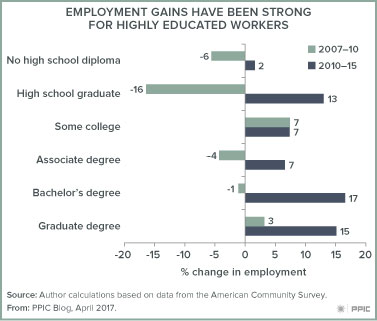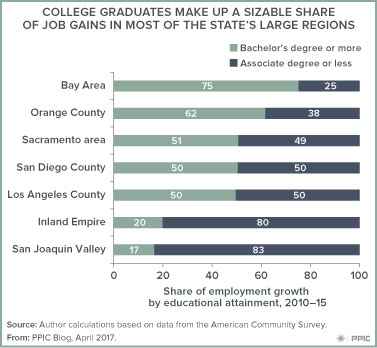Recessions and recoveries have the power to reshape our economy and workforce. In California, the latest recession and recovery have had very different consequences for workers based on their educational attainment levels. During the Great Recession, most job losses occurred among less educated workers, and the subsequent recovery has seen stronger gains for highly educated workers.

After declining to a nadir in 2010 with the Great Recession, the number of employed workers in California has grown substantially, increasing by 1.6 million among adults of prime working age (20 to 64) between 2010 and 2015, according to data from the American Community Survey. During the recovery, the rate of employment growth has been highest for workers with a bachelor’s degree or graduate degree (see chart). Even though high school graduates have also fared relatively well in the recovery, they suffered the most in the recession and recent gains have still not offset the job losses they sustained from 2007 to 2010.
These employment gains reflect the changing nature of our economy. Many of the fastest-growing occupations rely on highly educated workers, such as software developers, computer scientists, and management analysts. But other fast-growing occupations depend on less educated workers, such as taxi drivers and chauffeurs (including those that work for Lyft or Uber) and food preparation workers. Overall, occupations highly dependent on college graduates—those in which a majority of workers in 2010 had at least a bachelor’s degree—experienced a much faster rate of growth (14.1%) than occupations less dependent on college graduates (9.6%).

The changing nature of the state’s economy has also created regional winners and losers. The Bay Area, with its highly educated population, led the state in employment growth, adding more than 400,000 workers overall from 2010 to 2015, with college graduates making up 75% of those job gains (see chart). In contrast, the rate of employment growth was lowest in the San Joaquin Valley, where the demand for and supply of highly educated workers is relatively weak. In the Inland Empire and the San Joaquin Valley, college graduates accounted for only 20% and 17%, respectively, of employment gains.
California’s recovery from the Great Recession highlights the importance of the state’s higher education systems in providing meaningful economic opportunities for workers. Rather than being diminished by the most recent recession and recovery, a college education has emerged as an even more important determinant of labor market success.
Visit the PPIC Higher Education Center


